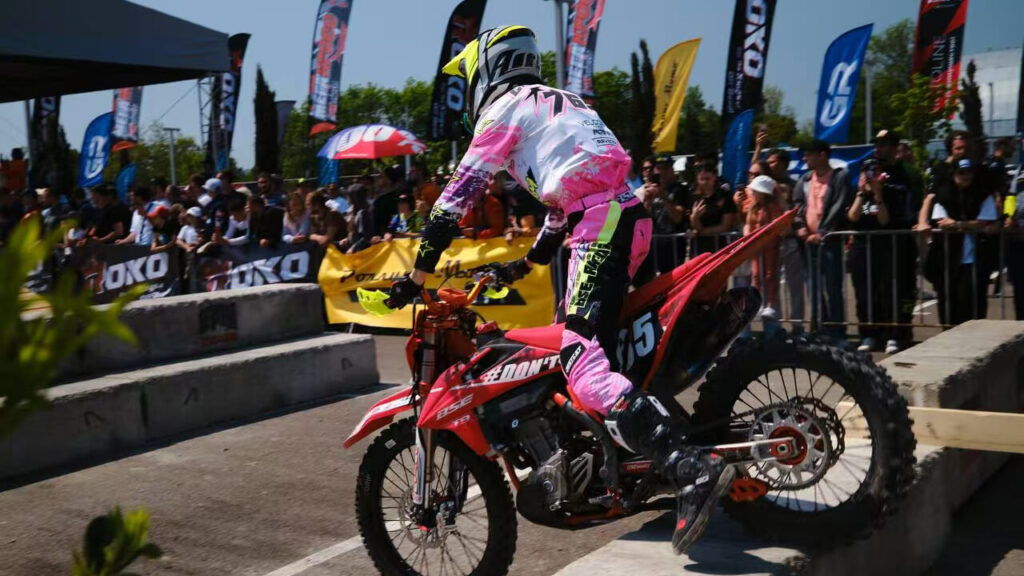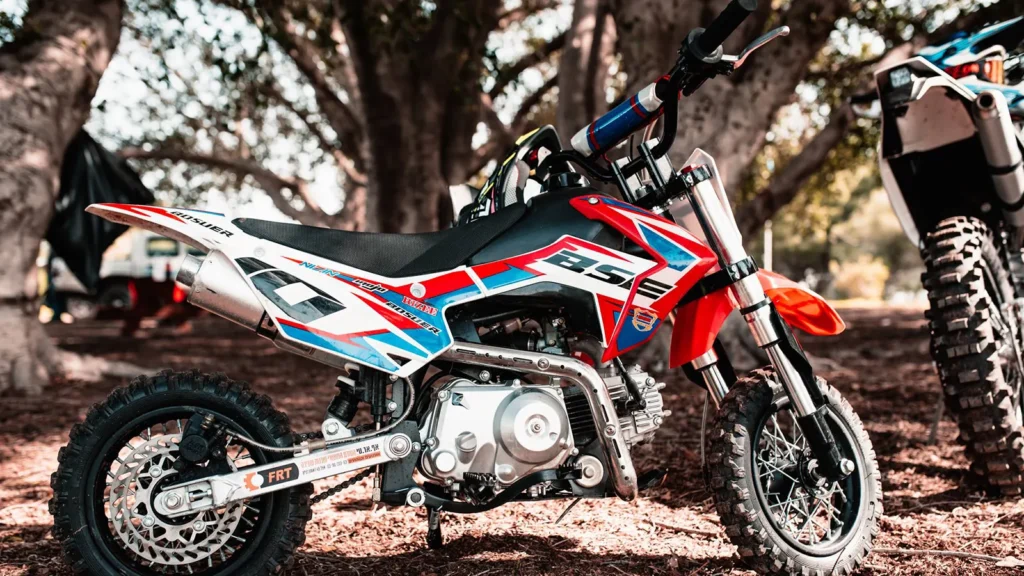La moto tout-terrain est une activité passionnante et amusante pour les adolescents et les jeunes, mais déterminer quand ils seront suffisamment matures pour s'élancer sur les pistes est une préoccupation majeure pour les parents et les entraîneurs. L'âge requis, les dimensions de la moto et les consignes de sécurité entrent en jeu. Nous détaillons ici les restrictions d'âge pour la pratique de la moto tout-terrain et vous aidons à prendre des décisions éclairées pour les jeunes pilotes.

Table des matières
BasculerQuel est l'âge légal aux États-Unis pour les motos tout-terrain ?
Aux États-Unis, il n'existe pas de règle nationale unique concernant l'âge requis pour conduire une moto tout-terrain. Tout dépend des réglementations au niveau des États.
Les lois sur les motos tout-terrain diffèrent considérablement d'un État à l'autre, selon qu'elles sont utilisées sur une propriété publique ou privée.
La réponse courte
Aux États-Unis, il n'existe pas d'âge minimum fédéral pour la conduite de motos tout-terrain. Cependant, la plupart des États ont des lois qui l'appliquent en fonction du lieu de conduite. Sur les terrains publics, comme les parcs nationaux ou les sentiers gérés par l'État, l'application est plus stricte. Les exigences d'âge, le port du casque et les formations à la sécurité y sont systématiquement appliqués. Sur les propriétés privées, c'est moins le cas.
Toutes ces lois s'appliquent aux compétitions organisées ou aux randonnées pédestres publiques. La Californie, par exemple, impose des conditions d'âge pour la conduite de VTT, et le Texas exige qu'un adulte accompagne les conducteurs mineurs de moins de 14 ans.
Dans chacun de ces États, l'usage de la propriété privée relève en premier lieu du contrôle des parents. Néanmoins, avec ou sans légalité, la prudence est toujours de mise. Pour des conseils juridiques plus détaillés, consultez le site Lois de la Fédération des consommateurs d'Amérique sur les motos tout-terrain.
Variations d'un État à l'autre
Voici quelques exemples de lois sur les motos tout-terrain dans quelques États populaires :
| État | Âge minimum (terrain public) | Casque obligatoire | Cours de formation requis |
| Californie | 6 ans (avec restrictions) | Oui | Oui (pour les moins de 18 ans) |
| Texas | Pas de minimum (avec encadrement) | Oui | Oui (si moins de 14 ans) |
| Floride | 6 ans | Oui | Oui (pour un usage public) |
| Michigan | 10 ans (avec certificat) | Oui | Oui (certificat VHR) |

Votre enfant est-il prêt à rouler ?
L'âge n'est pas le seul facteur qui déterminera si votre enfant est prêt ou non à faire du dirt bike. D'autres facteurs, comme sa préparation mentale et physique, doivent également être pris en compte.
Tout d'abord, l'enfant doit être physiquement capable de maîtriser la moto tout-terrain, c'est-à-dire de tenir son équilibre, d'actionner l'accélérateur et les freins avec aisance et, si possible, d'être assez fort pour la relever si elle tombe (si elle est petite). Ses pieds doivent pouvoir toucher le sol naturellement en position assise.
La coordination et le temps de réponse sont également importants ; un enfant qui possède une bonne coordination œil-main dans d’autres activités, comme le vélo ou les sports d’équipe, sera plus capable de suivre les décisions prises en une fraction de seconde que le dirt bike implique.
Outre la condition physique, une préparation mentale est également nécessaire. Choisissez un enfant qui obéit, suit les instructions et apprend de nouvelles choses avec maturité. Il doit être disposé à respecter les consignes de sécurité, à porter un équipement de sécurité et à comprendre que le motocross n'est pas un jeu, mais un engagement sérieux.
La confiance est meilleure, mais l’excès de confiance est dangereux ; votre enfant sera meilleur s’il est calme mais respecte la machine.
Si vous avez encore des doutes, les observer faire du vélo ou une draisienne sur des terrains variés vous donnera une idée de s'ils sont prêts à faire du dirt bike ou non.
Recommandations de motos tout-terrain en fonction de l'âge
L'âge est le facteur principal dans le choix d'une moto tout-terrain pour enfant. La taille, le niveau de confiance, le développement moteur et l'expérience de conduite sont également des facteurs à prendre en compte. Voici une répartition approximative des âges pour les recommandations de motos.
3 à 6 ans : Mini motos (50 cc)
Il s'agit de la tranche d'âge la plus jeune à laquelle les enfants doivent commencer à conduire une moto tout-terrain. Cette tranche d'âge est adaptée à un moto tout-terrain à moteur 50cc, de préférence une moto tout-terrain à roues stabilisatrices. Les motos tout-terrain sont basses et offrent une faible réactivité à l'accélérateur pour une sécurité maximale.
7-9 ans : motos de 50 cc à 70 cc
Les enfants de cet âge préfèrent une 50cc semi-automatique ou automatique à moto tout-terrain 70ccPlus puissante qu'une mini moto, elle est légère et compacte. Les motos tout-terrain comme la BSEMotor 70 cm³ avec limiteurs d'accélérateur sont idéales pour les enfants débutants ou intermédiaires.
10-12 ans : modèles 70 cc à 110 cc
En toute confiance et en toute sécurité, les préadolescents peuvent gérer 70 cc–motos tout-terrain à moteur 110ccApprenez-leur à utiliser des transmissions manuelles, qui permettent aux jeunes pilotes de piloter et d'améliorer leur technique. Privilégiez celles dont l'accélérateur est réglable en fonction de leur niveau.
13-15 ans : motos tout-terrain de 125 cc à 150 cc
Les jeunes pilotes qui se préparent à une conduite agressive sur sentier ou à un motocross passeront à un 125cc ou moto tout-terrain 150ccIls sont puissants et plus rapides, et sont idéaux pour une première utilisation en motocross. Les adolescents de cet âge doivent porter un équipement de protection complet en permanence.
16 ans et plus : moto tout-terrain 150 cc et plus
À 16 ans, un adolescent peut conduire une moto tout-terrain plus puissante, généralement une moto dont la cylindrée est supérieure à 150 cm³. À ce stade, 150 cm³ à Moto tout-terrain 250cc Les balades sont appropriées. La plupart des adolescents peuvent conduire une 250 cm³ en toute sécurité, à condition de bénéficier d'une formation et de conseils adéquats.
L'âge n'est pas le facteur déterminant pour choisir la moto tout-terrain idéale. Tenez compte de la taille du pilote, de sa capacité à s'asseoir dessus et à toucher le sol, et de son confort. Une taille de moto adaptée améliore le contrôle, la sécurité et le plaisir de conduite.

Lois sur les terres publiques et les propriétés privées
L'âge de l'enfant et le vélo qu'il utilise sont des facteurs importants, tant sur le plan juridique que sécuritaire. Les règles de sécurité, les limites d'âge et les exigences de formation varient d'un État à l'autre, en fonction de la législation locale et de sa mise en œuvre. Certains États sont très stricts concernant les limites d'âge, exigeant des mineurs qu'ils suivent des cours de sécurité, notamment pour la pratique du VTT sur les sentiers publics, dans les parcs ou lors d'événements officiels. D'autres organisations peuvent être moins formelles, mais elles s'accordent à dire que le respect des bonnes pratiques de sécurité est fortement recommandé.
Les parcs et pistes de motocross publics imposent également des restrictions d'âge strictes et une classification des pistes par niveau afin de garantir une expérience en toute sécurité. Certains utilisent même un système de classification des niveaux de compétence par âge.
Des clubs comme le Association américaine des motocyclistes (AMA) est très précis sur les tranches d'âge pour les jeunes coureurs entre 4 et 17 ans, avec des catégories de vélo spécifiques pour chaque tranche.
Comment choisir la moto tout-terrain idéale pour votre enfant
Choisir la moto tout-terrain idéale pour votre enfant ne se résume pas à une simple question de puissance. Il faut également prendre en compte le confort, le contrôle et la durabilité. Voyons cela en détail.
- Hauteur et poids du siège : Demandez à votre enfant de s'asseoir de manière à pouvoir poser le pied à plat sur le sol. Cela améliore son équilibre et sa confiance.
- Type de transmission : Le mode automatique facilite l'utilisation pour les jeunes pilotes ou les pilotes inexpérimentés. Avec l'expérience, l'utilisation d'une option semi-automatique ou manuelle offre un meilleur contrôle.
- 2 temps ou 4 temps: Les motos tout-terrain à 4 temps sont plus populaires auprès des étudiants car elles sont habituées à une puissance de sortie et à un entretien plus simple. motos tout-terrain à 2 temps sont plus légers, plus rapides et parfaits pour les cavaliers âgés ou seniors.
- Gaz ou électricitéLes motos tout-terrain électriques, silencieuses, légères et sans entretien, sont idéales pour les jeunes apprentis pilotes. Puissantes et dotées de batteries plus durables, les motos tout-terrain à essence sont particulièrement adaptées aux adolescents.
- Limiteurs d'accélérateur:Les commandes d'accélérateur de la plupart des modèles de vélos pour jeunes peuvent être ajustées pour maintenir la vitesse sous contrôle pendant l'apprentissage.
Évitez les vélos trop grands pour qu'un enfant grandisse. Les vélos trop grands ne sont pas plus sûrs et peuvent miner la confiance en soi. En savoir plus choisir la bonne taille de vélo pour les nouveaux cyclistes.
Besoins en matière de formation et d'équipement de sécurité
La sécurité n'est pas une option, c'est la base d'une conduite sécuritaire en moto tout-terrain. Les jeunes pilotes, quel que soit leur âge ou leur lieu de résidence, doivent toujours être bien équipés et avoir accès à une formation.
Un ensemble complet d'équipements de moto tout-terrain pour jeunes est :
- Casque: Approuvé par le DOT, ajustement correct
- Lunettes: Éloignez la poussière, la boue et les débris des yeux
- Paire de gants: Aide à améliorer l'adhérence et à réduire les éraflures
- Bottes: Soutien et protection de la cheville
- Gilet pare-balles : Protection de la poitrine, des coudes et des genoux pour les jeunes cavaliers
Presque tous les États exigent actuellement que les conducteurs de moins de 18 ans suivent un programme certifié. Éducation à la sécurité des VTT ou des VHR Cours. Ces cours enseignent aux étudiants les fondamentaux, notamment le contrôle de l'accélérateur, le freinage, la conduite sur sentier et la formation aux situations d'urgence. D'excellents cours de sécurité pour enfants et adultes sont proposés par des groupes comme l'ATV Safety Institute et l'école de motocross MSF.
Déterminer l'âge et le vélo appropriés à utiliser pour rouler en toute sécurité
Il n'y a pas d'âge idéal pour conduire une moto tout-terrain. Pourtant, avec un bon équilibre entre observation, développement des compétences et équipement adapté, les jeunes peuvent s'amuser et rouler en tout-terrain en toute sécurité. En tant que parent, propriétaire ou instructeur, c'est la préparation du pilote qui compte, et non son âge.
Bosuer s'engage à offrir aux professionnels des motos tout-terrain fiables et appréciées des jeunes, des conseils aux vétérans et des conditions d'achat pratiques. Visitez notre showroom dès aujourd'hui et aidez les jeunes à prendre le bon chemin et à rouler de manière responsable.
FAQ
1. Combien dois-je dépenser pour une moto tout-terrain en tant que débutant ?
Une moto tout-terrain de qualité pour débutants coûterait entre $500 et $1 500. moto tout-terrain électrique son prix serait probablement inférieur, mais une moto tout-terrain à essence avec une suspension et des matériaux améliorés pourrait coûter plus cher.
2. À quelle fréquence les motos tout-terrain pour jeunes doivent-elles être entretenues ?
L'entretien dépend de l'utilisation et de la fréquence. En règle générale, il est impératif de vérifier pression des pneusVérifiez la tension de la chaîne, les freins et le niveau d'huile avant chaque sortie. Un contrôle plus approfondi, comme le nettoyage du filtre à air, la lubrification des pièces mobiles et la vérification du moteur, sera nécessaire toutes les 10 à 15 heures de conduite.
3. Une moto tout-terrain est-elle associée à la motricité et à la coordination d'un enfant ?
Oui. Une moto tout-terrain peut contribuer à développer certaines qualités de votre enfant. Elle contribue à développer la coordination œil-main, l'équilibre, le temps de réaction et la capacité de décision. La répétition apportera aux jeunes pilotes confiance, sens des responsabilités et conscience corporelle, selon la plupart des écoles d'équitation.
4. Existe-t-il des compétitions de dirt bike pour les jeunes ou les novices ?
Oui. L'American Motorcyclist Association (AMA) certifie les événements pour jeunes par groupes d'âge, les circuits pour débutants et les événements axés sur la sécurité. pistes de motocross Nous organisons également des camps d'entraînement et des événements discrets pour les nouveaux motocyclistes.
5. Est-il possible de conduire une moto tout-terrain toute l'année ?
Oui, c'est possible, mais cela dépend de votre situation géographique. Dans les pays au climat plus chaud, le dirt bike se pratique toute l'année. En revanche, dans les régions froides et pluvieuses, les motos doivent être équipées de pneus spéciaux et nécessitent un entretien particulier. En hiver, les pistes de dirt bike indoor sont une excellente alternative.
